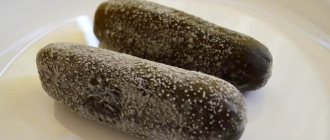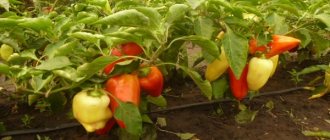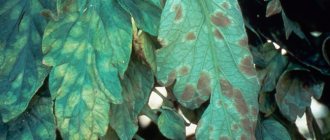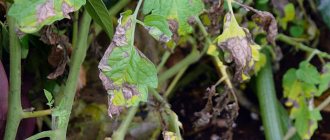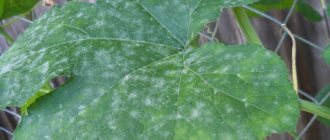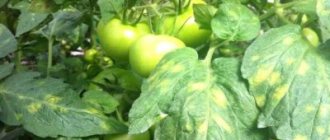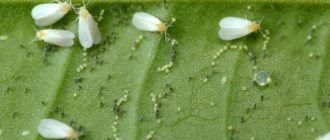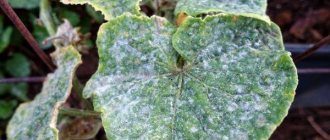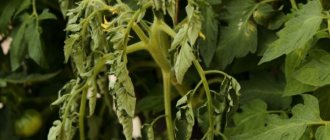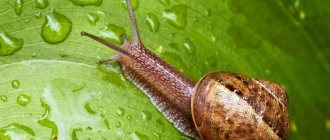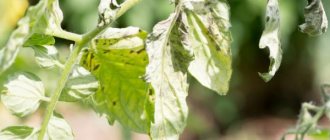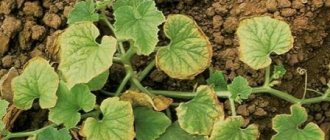Cucumber root rot is a disease that is common both indoors and outdoors and manifests itself throughout the growing season. It is complex and results from unfavorable growing conditions that weaken plants and thereby promote the development of parasitic soil pathogens. If the correct conditions for growing cucumbers are not observed, the death of seedlings reaches 60-80%, and the yield decreases to 23-38%. The disease is widespread throughout the crop growing area.
Signs of the disease
The seedlings are weak and develop slowly. An external characteristic sign is that the base of the stem becomes thinner and has a brown tint, the cotyledons and young leaves fade, and the plant dies very quickly. These are typical manifestations of the so-called “black leg”. On a cut of the root, browned vessels in which the fungal mycelium develops are clearly visible. The mycelium is white, cobwebby, with a pink or yellowish tint.
In adult plants, the lower leaves first wither during the hottest hours of the day; at night they are restored. Then the withering intensifies and becomes irreversible. The leaves wrinkle, bend, turn brown and dry out. Young fruits become underdeveloped. The root collar and roots also turn brown, their surface tissues become rotten.
Let's figure out what to do if cucumbers rot in a greenhouse
If the sprouts, ovary, or even the small cucumbers themselves are covered with a whitish coating, become soft, or unsightly brown or gray spots appear on the leaves, then we are dealing with rot. It’s unpleasant, but it’s a fact: most likely, it’s unlikely that it will be possible to save plants that have already been completely damaged, but if you want to get a healthy, rich harvest next year, you need to take a number of preventive measures.
If plaque appears on cucumbers or stems, it is necessary to carry out preventive maintenance on your plant
In order to protect the next crop of cucumbers, you need to:
- Remove all plant debris after harvest. They not only need to be removed from the greenhouse, but also burned to destroy all the fungus;
- Treat the entire greenhouse or greenhouse with chemicals. The soil and substrate must be sprayed with bleach. It’s worth walking along the supports of the greenhouse and its walls. Then it is worth spraying again with copper sulfate mixed with thiophos or formaldehyde solution. The last step is to use insecticides.
- Before planting, the seeds also need to be treated - often the fungus can infect both the plants themselves and leave its spores in the seeds. They need to be treated with high temperature twice to destroy the infection.
Do not use seeds from already infected cucumbers. It is better to purchase fresh seedlings or seeds before the new season.
In addition to preventive measures before planting, it is worth considering in more detail the causes and symptoms of the most common types of cucumber rot in order to be able to at least partially combat it when it occurs.
Protection measures
1. In open ground, it is necessary to observe crop rotation, and in protected ground, replace the soil periodically at intervals of 3-4 years.
2. During the growing season, it is necessary to maintain optimal conditions in the area of the cucumber root system:
- soil temperature should be between 20-26 C;
- humidity not higher than 85%, optimally 76-78%.
3. To enrich the soil with “beneficial bacteria” that inhibit the development of rot pathogens, it is recommended to introduce biological products. Today, such drugs as “Pseudobacterin-2”, “Baktofit” , “Trichodermin” , “Fitolavin” .
3.1. “Pseudobacterin-2” is a biological fungicide for the fight against pathogens of fungal and bacterial diseases with a clear growth-stimulating effect. Available in the form of a liquid concentrate, it is usually applied to the surface of the seeds before sowing, by pre-soaking.
3.2. “Baktofit” is a bacterial fungicide with a contact mechanism of action; the bacteria Bacillus subtilis of this strain IPM 215 synthesize an antibiotic that suppresses the activity of pathogenic fungi. Available in the form of powder or suspension concentrate.
Methods of using "Baktofit":
- Soaking cucumber seeds before planting for a day (1 ml of suspension or 1 g of powder or 500 ml of water);
- Soaking the root system when replanting plants (dip, soak in solution for 2-5 minutes);
- Spraying plants on the leaves and watering the soil at the roots during the growing season (dilute the working solution 3 ml per 1 liter of water);
- Combined use with herbicides (reduces the content of toxicogenic soil fungi).
Repeated applications are required every 7 days, three times in total, then the drug must be changed if the disease is not cured or further prophylaxis is required, although manufacturers recommend up to 7-8 applications, since the drug does not cause resistance.
3.3. Trichodermin is produced in the form of an aqueous suspension or dry powder. In any form, the product contains more than 9 billion live mushroom spores (in 1 gram or 1 milliliter).
Methods of using Trichodermin:
- Application into planting holes. To do this, 4 grams of Trichodermin powder are diluted in 4 liters of water and poured onto the soil of the planting hole. It is possible to treat open ground with a 2% solution of the drug;
- Soaking seeds. Carry out during the day in a solution of the drug (1 ml of suspension or 1 g of powder or 500 ml of water);
- For root rot of adult cucumber plants, a solution is prepared based on the following proportions: per 1 liter. water (without chlorine!!!) you need 5 grams of powder. Processing is carried out by irrigation;
- Preventive treatments are carried out only after the appearance of 2 leaves on the plant. Treatment is carried out no more than once a month.
3.4. "Fitolavin" is a bioantibiotic. The work of this fungicide is based on the fact that the active substance - phytobacteriomycin , penetrating inside the plant and circulating with sap flow through the tissues, has a detrimental effect on pathogens. The active substance interacts with the ribosomes of bacteria, disrupting the synthesis of their protein, which leads to a change in the genetic code of the causative agents of bacteriosis. All this ultimately helps the plant to protect itself not only from the introduction of pathogens, but also to resist their development for a long time.
Examples of the drug "Fitolavin" produced by various manufacturers
Available in the form of a water-soluble concentrate. Regulations for the use of “Fitolavin” for treating cucumbers against root rot can be found in a separate material.
4. If cucumber seedlings are not treated with biological preparations, then it is advisable to treat them with TMTD or Previkur Energy .
4.1. “TMTD” is a contact fungicidal seed protectant for many agricultural crops against a complex of diseases transmitted through seeds and soil. Available in the form of a water-suspension concentrate. Active ingredient: thiram, 400 g/l. This drug has a contact effect, disrupts the development of the vegetative and generative organs of fungi - pathogens found on the surface of seeds and in the soil. Suppresses external and soil infections within just 2 days. The drug shows high effectiveness against external seed infections, as well as root and basal rots that develop in the initial phases of plant development.
4.2. "Previkur Energy" is a drug that successfully combines the actions of a protective pesticide and an immunizing fungicide.
Examples of Previkur Energy drugs
It is used to protect cucumbers from root and basal rot at the stage of preparing seeds, growing seedlings and adult plants. 2-component fungicide (Propamocarb, 53% + Fosethyl aluminum, 31%). Watering of seedlings is carried out at the root 14 days after sowing the seeds. The first watering is 4-7 days after planting the seedlings in a permanent place, subsequent waterings (up to 4 times) - with an interval of 2 weeks.
Gray rot
If the temperature is low at night, you water it with cold water, there is a high planting density, and there is unsatisfactory ventilation in the greenhouse structure, then it can come and visit you, actively spreading, gray rot.
Crowded plantings can lead to the formation of a large number of male flowers. Up to 10-15 barren flowers can form in the axil of one leaf, which usually leads to their death and rotting after a couple of days, thereby affecting strong stems.
Rot manifests itself in the form of slimy gray spots appearing on the stems (most often at the branches), as well as in the axils of the leaves.
What we do
- We grow self-pollinating hybrids. We do not allow the formation of a tight fit. If a large number of barren flowers appear after they bloom, we immediately cut them off. Sprinkle the injured areas with wood ash or finely ground charcoal.
- We ventilate the greenhouses and stop watering for a short time.
- Also, do not forget to be careful when watering or fertilizing to get it on the crop.
- Infected plants can be dusted by covering the injured areas with a teaspoon of copper sulfate with a glass of wood ash and chalk, mixed well.
- With the active development of the sore, with a high degree of infection, the shoots must be cut out and then burned.
- We apply treatment with 40 g of the drug “Hom” -10 l. In the morning in warm weather, using a sprayer, we carry out spraying work twice with a break of 5-6 days. Upon completion of the culture, dry it by opening one window.
Conclusions and recommendations
Thus, timely detection of damage to cucumber crops by a fungus - PEST and the use of simple agrotechnical techniques (cleaning and destruction of plant residues, compliance with crop rotation and regime, introduction of resistant varieties) together with the use of biological products (seed dressing, soil disinfection) will help you easily overcome this " disease" and save the plants. And by preserving the plantings, you will not be left without a good harvest.
*Changes and additions were made on July 11, 2019.
If cucumbers rot in a greenhouse: preventive measures
When growing vegetables in a greenhouse, rot can also occur. The main difference between prevention in greenhouses is that all actions should be carried out only in the absence of frost, because the heat quickly evaporates when the greenhouse is opened.
Growing vegetables in a greenhouse requires prevention and treatment
To prevent rot, you should monitor the amount of moisture in the soil and air, maintain the microclimate around +18 degrees, shade the greenhouse if necessary, and be sure to monitor the presence of condensation inside - there should not be any.
Brown spot
A fungal disease that affects fruits. If the humidity is exceeded, it affects seedlings, leaves, and stems.
The first signs of brown spot are small watery spots. They increase in size quickly (the diameter can increase by 2-5 mm per day). The skin cracks and pimples appear on the fruit. Subsequently, the cucumbers rot, and the disease is transmitted to neighboring bushes.
Fighting methods
To eliminate brown spot, you need to do certain procedures. Methods to combat the disease:
- at the first signs of damage, remove the top layer of soil;
- ventilate the greenhouse or greenhouse;
- reduce the amount of watering.
Bordeaux mixture gives good results. It is a mixture of copper sulfate and milk of lime. Stick to the ratio - 300 grams of copper sulfate and 400 grams of lime. Add 2-3 liters of hot or warm water. After preparation, the solution is not diluted with water. Otherwise, it will delaminate and will not give the desired results.
Folk remedies
Treatment of white rot with folk remedies on cucumbers in a greenhouse and open ground will give a positive result at the initial stage of development. You can use a milk-iodine solution. It is prepared from:
- 10 liters of water;
- 1 liter of milk;
- 10 g iodine.
To ensure that the mixture adheres well to the plant, it is recommended to add 10 g of crushed laundry soap or 40 ml of liquid soap to it. There is another recipe for a medicinal composition that should be used to lubricate wounds and cuts formed after the removal of sclerotia. Take the same amount of crushed soap and ash, add so much water so that the consistency of the composition becomes like a thick paste.
A solution of soda with manganese helps get rid of white rot. To prepare it you will need 8 tbsp. potassium permanganate and soda dissolved in 10 liters of water. 1 tbsp is also added there. crumbled laundry soap. This mixture should be sprayed on diseased bushes.
Attention!
If you fight white rot with folk or chemical means, then you must definitely feed it with phosphorus-potassium fertilizers. They are needed to make plant tissues stronger and more resistant to infections.
